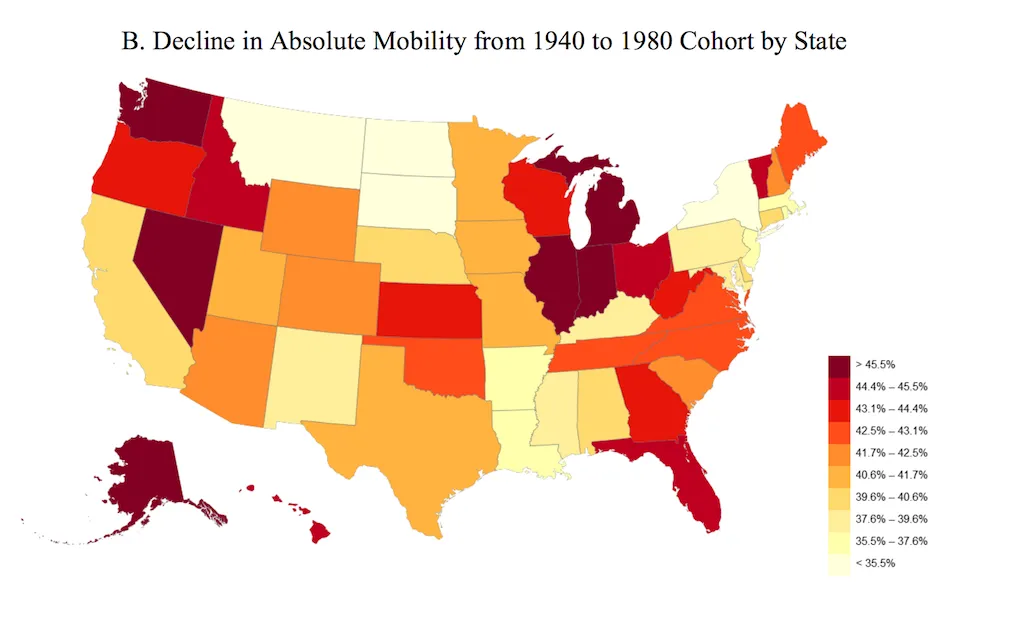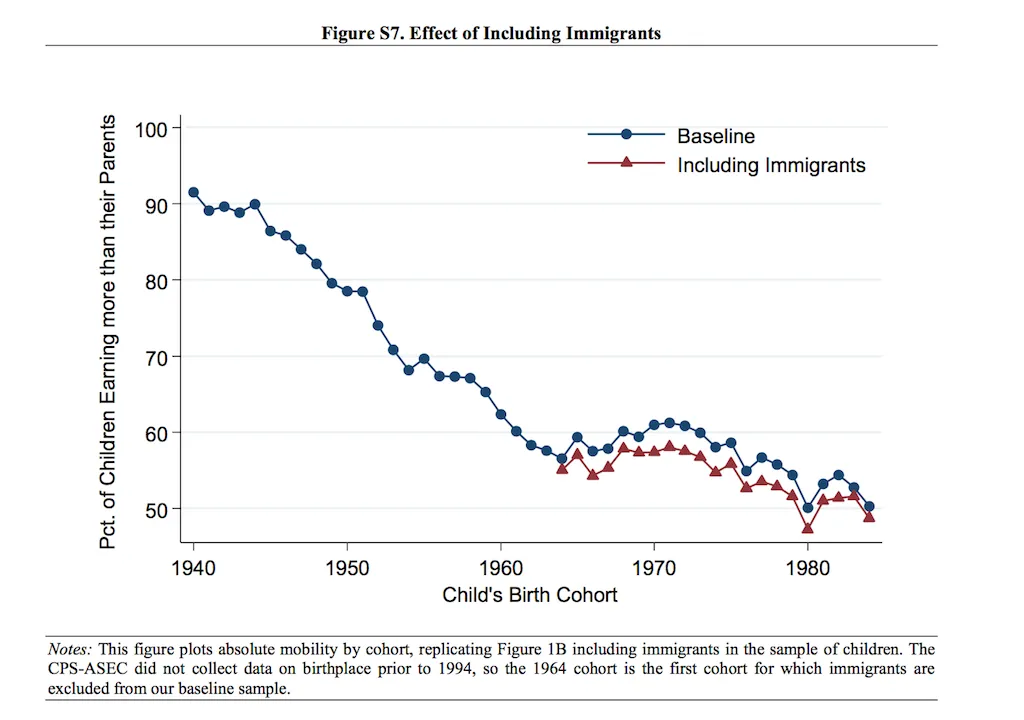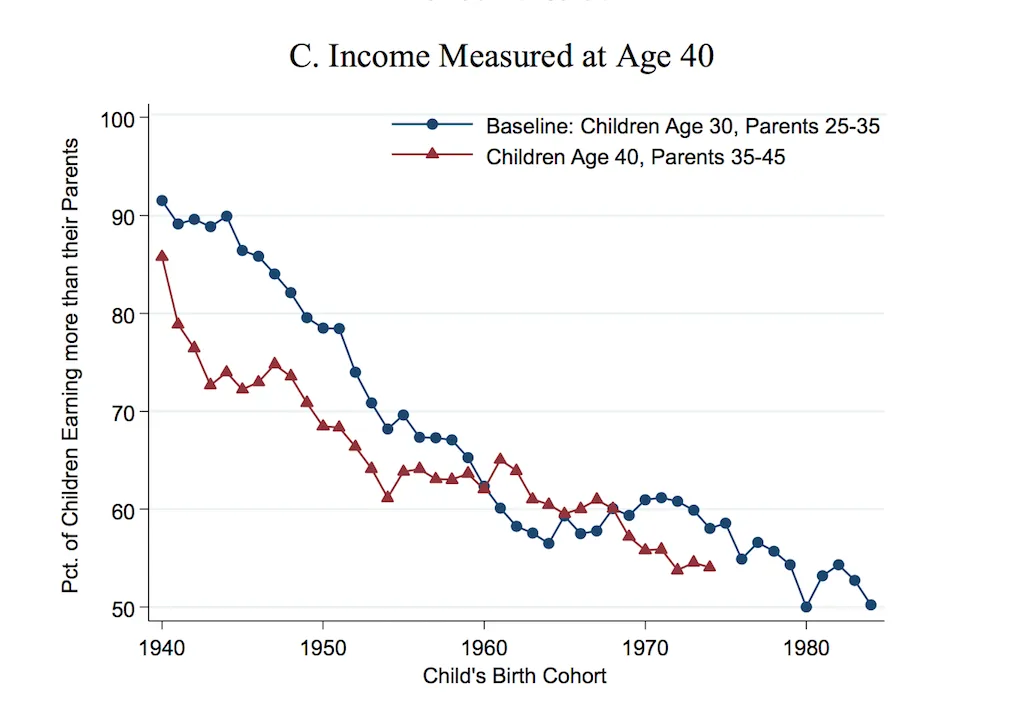
Introduction
Whilst listening to the Freakonomics podcast yesterday I came across an interesting discussion.
http://freakonomics.com/podcast/american-dream-really-dead/
The podcast asked the question, "Is the American Dream Really Dead?".
If focused on the research of a number of economists and organisations, in particular the work of Raj Chetty looking at the issue of upward income mobility in the USA.
Upward income mobility is seen as the "defining feature" of "the American Dream" and refers to the ability of children to earn more than their parents.
Raj Chetty

Image Source
Chetty is a professor of economics at Stanford University who is using big data and computational methods to analyse economic issues.
He is also part of something called the Equality of Opportunity Project which states:
"We use big data to identify new pathways to upward mobility."
They have a lot of papers and data on their website including a downloadable version of the information that Chetty Discusses on the podcast:
Link for the PDF: http://www.equality-of-opportunity.org/papers/abs_mobility_paper.pdf
The Paper - the Fading American Dream
The paper is actually quite long at 54 pages. A large chunk of this is taken up with statistical data, figures and supplementary materials.
The authors use a number of data sources including that taken from Censuses and Tax records to construct their study.
Main Findings

The basic "take home" finding is that:
"rates of absolute mobility have fallen from approximately 90% for children born in 1940 to 50% for children born in the 1980s. The result...is robust to the choice of price deflator, the definition of income, and accounting for taxes and transfers"
This would suggest that a central tenet of the "American Dream" - that of upward mobility has almost halved in the last half century.

There also seemed to be substantial geographic and demographic variability:
"Absolute mobility fell in all 50 states between the 1940 and 1980 cohorts, although the rate of decline varied, with the largest declines concentrated in states in the industrial Midwest states such as Michigan and Illinois. We also find substantial declines in absolute mobility for both sons and daughters when income is measured at the household level. The decline in absolute mobility is especially steep – from 95% in the 1940 cohort to 41% in the 1984 cohort – when we compare the individual earnings of sons to their fathers."
What is the Cause of the Decline?
The authors consider this:
"There have been two important macroeconomic trends that have affected the incomes of children born in the 1980s relative to those born in the 1940s: lower Gross Domestic Product (GDP) growth rates and greater inequality in the distribution of growth (Goldin and Katz 2008)."
In order to study these factors they used computer simulations on the actual statistics to adjust them for scenarios of both higher GDP growth and reduced inequality in growth distribution.

In the higher GDP simulation they found:
"absolute mobility rises to 62%, closing 29% of the gap in absolute mobility between the 1940 and 1980 birth cohorts"
So this would only appear to be responsible for under a third of the difference.
In the better growth distribution (but stable GDP) scenario they found:
"the rate of absolute mobility rises to 80%, closing 71% of the gap in absolute mobility between the 1940 and 1980 cohorts"
This suggests that the decline in upward mobility is primarily an issue of unequal growth distribution rather than GDP.
GDP growth is a factor but if this issue is to be tackled it cannot done so purely through growth - although growth might help.
Statistics

There is the old line that one often hears attributed to British Prime Minister Benjamin Disraeli:
"There are lies, damned lies and statistics."
By it's nature a paper of this kind contains a huge amount of statistics.
The sheer amount of data presented here makes it quite hard to follow and assess.
One could see this as one of the caveats of the big data approach.
I will therefore apologise in advance if I have misunderstood anything.
Exclusions Are Hard To Assess

Using tax and census data by definition excludes certain groups because not everyone pays tax and not everyone fills in census forms.
The authors consider those with no tax returns to have an income of "0". Parent's with this rating are excluded from the data.
The author's do address this somewhat:
"This does not pose a problem for measuring absolute mobility because children whose parents have zero income always earn at least as much as their parents. We calculate the fraction of parents with zero income in each cohort based on Census data and include these individuals when computing average rates of absolute mobility, assigning the group of children whose parents have zero income an absolute mobility rate of 100%."
I can't really speak to the validity of this method - one would assume that it reduces the likelihood of over overestimating the changes to upward mobility.
Immigrants

The authors also excluded immigrants due to difficulties of assessing parental incomes.
I can understand why this was done but in a nation which is substantially formed from immigrants this is a large demographic to exclude.
The concept of the "American Dream" is perhaps even greater for foreigners and people of non US birth who see it as a land of opportunity.
The authors used a substantial amount of statistical computation to make estimates for overcoming other gaps so I was surprised that a workaround was not found for this.
I am not an economist or statistician though so perhaps there is some reason which makes this a lot harder.
Time to Peak Lifecycle Earnings

Another possible anomaly that was considered is the fact that in modern times it may take longer for people to reach their maximal income (peak lifecycle earnings).
What most people may have achieved in their 30s fifty years ago might only be achieved in people's 40s or even later now.
The authors did consider this:
In our baseline analysis, we measure children’s incomes at age 30. One may be concerned that children take a longer time to reach peak lifecycle earnings in more recent cohorts, which could lead to a spurious downward trend in rates of absolute mobility. Figure 3C addresses this concern by replicating our baseline analysis measuring income at age 40 for children (for the 1940-74 cohorts) and at ages 35-45 for parents. This series continues to exhibit a sharp decline in absolute mobility across birth cohorts. The time pattern of the decline is shifted backward by approximately 10 years, consistent with measuring incomes 10 years later.
So this suggests that it made little difference according to their analysis (see graph).
A "Blip" in the Data

One final interesting finding in regards to the overall decline in mobility is that:
"The decline paused for children born in the late 1960s and early 1970s, whose incomes at age 30 are measured in the midst of the economic boom of the late 1990s. Absolute mobility then continued to fall steadily in the remaining birth cohorts."
This would correspond to the growth of the internet.
I wonder if we could see a similar boost as a result of blockchain technologies like Bitcoin and Steemit in future years?
Many have compared the current state of blockchain technology to the Internet in the 1990s and it is easy to see the parallels.
Discussion

The findings of the study are certainly interesting and the reduction in social mobility will probably chime with a lot of millennials who are in the current jobs market.
I think there is a general perception that the opportunities for people now are considerably less than those for their parents.
The study would also suggest that there are certain areas such as mid-western states that were traditionally industrial hubs where the inequality is even greater.
The finding that this is more a problem of inequality of growth distribution rather than GDP growth (about 70% vs 30%) will probably also resonate with a lot of people.
It is perhaps not a coincidence that Donald Trump directly addressed some of these issues - indeed in one of the audio clips in the podcast he actually says:
"The American Dream is dead".
It would also be interesting to see how these social mobility findings apply in other countries.
They do actually discuss this a little in the podcast.
In relation to mobility from the lowest income 20% to the highest 20% the rates of social mobility are slightly higher in the UK.
The rates for the US are about 6% for this group, in the UK they are about 6%.
Apparently Canada is the "land of opportunity" for the poorest people because the rate there is about 13%.
I would be interested to see how the overall rates compare with these figures.
Conclusion

I hope you have found this post useful.
I think the findings that upward mobility is declining don't just apply to the US.
There is at the very least a perception that it applies to most of the developed world.
Personally I think it is a bit early to say that the "American Dream" is dead. I think this is a concept that is bigger than just a single measure of mobility.
I am not an American and the idea of the "dream" means something to me too. It is about striving and working towards bettering yourself.
I believe it is one of the most successful and important American exports and I don't think it will ever truly "die".
No matter how tough times are it will always exist in people's minds and, dare I say, hearts.
What do you think?
References
- Chetty, Raj, David Grusky, Maximilian Hell, Nathaniel Hendren, Robert Manduca, and Jimmy Narang. 2016. “The Fading American Dream: Trends in Absolute Income Mobility Since 1940.” NBER WORKING PAPER SERIES, December. https://papers.ssrn.com/sol3/papers.cfm?abstract_id=2883926.
Thank you for reading

Before you go have you filled in the Coinbase form to list STEEM? It only takes a few seconds. THIS POST shows you how.
If you like my work please follow me and check out my blog - @thecryptofiend
Images are taken from the supplemental materials and my personal Thinkstock Photography account. More information can be provided on request.
